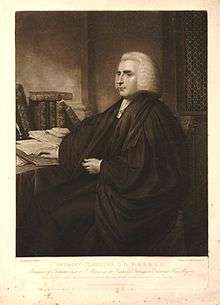Anthony Hamilton (Archdeacon of Colchester)

Anthony Hamilton (1739–1812) was an English Anglican priest, archdeacon of Colchester from 1775.[1][2]
Life
His father Alexander Hamilton was the fifth son of William Hamilton the antiquarian, who died in 1724;[3] he married the heiress Charlotte Styles, and so acquired the Essex manor of Holyfield (Hallifield), in the north-east of the parish of Waltham Abbey. It remained in the family into the 19th century.[4] The Hamilton family owned also the Debden Hall farm and estate (see Debden House).[5] The owner of Debden Hall Was Alex. Hamilton on a map of 1777.[6]
Venn's Alumni Cantabrigienses proposes the identification of Alexander Hamilton as the London solicitor of the name.[1] He moved to Loughton, transferring the remains of Charlotte and three children to be reburied there in 1744.[7]
Anthony Hamilton was a younger son of the marriage.[8] He was educated at Harrow School and entered Corpus Christi College, Cambridge in 1755. He graduated B.A. there in 1760, M.A. in 1763, and D.D. in 1775.[1]
Ordained deacon in 1762 and priest 1763, Hamilton became vicar of Fulham, and then in 1766 of Orsett in Essex. He was elected a Fellow of the Society of Antiquaries of London in 1773, and of the Royal Society in 1777.[1][9] In 1770, on the death of John Jortin, Hamilton became Archdeacon of London; in 1775 he gave up the post, to become Archdeacon of London.[10]
In 1776 Hamilton became rector of Much Hadham in Hertfordshire, and gave up his Fulham living; he became also vicar of St Martin-in-the-Fields.[1][11] In the 1790s he lived at 16 Savile Row, London.[12] He was buried at Loughton, with memorials set up in the Much Hadham and Little Hadham churches.[7]
Family
Hamilton married Anne Terrick, daughter of Richard Terrick; William Richard Hamilton was their son.[13] Anthony Hamilton the Archdeacon of Taunton was their second son, and the father of Bishop Walter Hamilton.[14]
Notes
- 1 2 3 4 5 "Hamilton, Anthony (HMLN755A)". A Cambridge Alumni Database. University of Cambridge.
- ↑ 'Archdeacons: Colchester', in Fasti Ecclesiae Anglicanae 1541–1857: Volume 1, St. Paul's, London, ed. Joyce M Horn (London, 1969), pp. 12-14 http://www.british-history.ac.uk/fasti-ecclesiae/1541-1857/vol1/pp12-14 [accessed 5 September 2015].
- ↑
 Stephen, Leslie; Lee, Sidney, eds. (1890). "Hamilton, William (d.1724)". Dictionary of National Biography. 24. London: Smith, Elder & Co.
Stephen, Leslie; Lee, Sidney, eds. (1890). "Hamilton, William (d.1724)". Dictionary of National Biography. 24. London: Smith, Elder & Co. - ↑ 'Waltham Holy Cross: Introduction and manors', in A History of the County of Essex: Volume 5, ed. W R Powell (London, 1966), pp. 151–162 http://www.british-history.ac.uk/vch/essex/vol5/pp151-162 [accessed 7 September 2015].
- ↑ 'Loughton: Manors', in A History of the County of Essex: Volume 4, Ongar Hundred, ed. W R Powell (London, 1956), pp. 118–121 http://www.british-history.ac.uk/vch/essex/vol4/pp118-121 [accessed 2 September 2015].
- ↑ "parksandgardens.org, Debden Hall". Retrieved 8 September 2015.
- 1 2 Transactions of the Essex Archaeological Society. 14. The Society. 1918. p. 279.
- ↑ Elizabeth Ogborne (1814). The History of Essex: From the Earliest Period to the Present Time: Illustrated with Accurate Engravings of Churchs, Monuments. Longman, Hurst, Rees, Orme and Brown. p. 197.
- ↑ Thomas Thomson (1812). History of the Royal Society, from Its Institution to the End of the 18th Century. London, Baldwin 1812. Baldwin. p. lvi.
- ↑ s:Page:Fasti ecclesiae Anglicanae Vol.2 body of work part 2.djvu/55
- ↑ Thomas Faulkner (1813). An Historical and Topographical Account of Fulham: Including the Hamlet of Hammersmith. T. Egerton. p. 48.
- ↑ 'Cork Street and Savile Row Area: Table of notable inhabitants on the Burlington Estate', in Survey of London: Volumes 31 and 32, St James Westminster, Part 2, ed. F H W Sheppard (London, 1963), pp. 566–572 http://www.british-history.ac.uk/survey-london/vols31-2/pt2/pp566-572 [accessed 7 September 2015].
- ↑
 Stephen, Leslie; Lee, Sidney, eds. (1890). "Hamilton, William Richard". Dictionary of National Biography. 24. London: Smith, Elder & Co.
Stephen, Leslie; Lee, Sidney, eds. (1890). "Hamilton, William Richard". Dictionary of National Biography. 24. London: Smith, Elder & Co. - ↑ Charles Roger Dod (1855). Dod's Peerage, Baronetage and Knightage, of Great Britain and Ireland. S. Low, Marston & Company. p. 477.